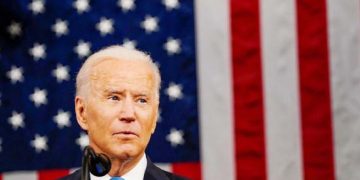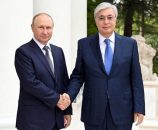Khaleej Times
Former US President Donald Trump’s isolationist and protectionist ‘America First’ policies seriously damaged America’s global leadership role. Raising tariffs on imports to the United States – particularly from China – succeeded only in prompting other countries to impose reciprocal tariffs on US goods. Trump’s trade policy, therefore, ended up hurting most Americans, from farmers to middle-class consumers.
Under Trump, America also unilaterally abandoned its global role, which would have enabled the US to tilt international rule-making regarding trade and the management of the climate crisis to its advantage. The US withdrew from the 2015 Paris climate agreement, the World Health Organisation, and the Trans-Pacific Partnership (TPP) trade deal and launched a contemptuous assault on the World Trade Organisation by refusing to agree to any appointments to the WTO’s appellate body.
Trump’s isolationism was particularly painful for America’s key allies in Europe and Japan. When the US abandoned the moral high ground of free trade and rules-based multilateralism, it threatened their values, too.
President Joe Biden’s administration quickly reversed many of Trump’s economic, environmental, and Covid-19 policies, including returning the US to the Paris accord and reversing America’s withdrawal from the WHO. But Biden has been very slow to roll back his predecessor’s protectionist trade measures. Nearly a year into Biden’s term, some of the Trump tariffs remain in place. There is no talk of America joining the TPP’s successor, the Comprehensive and Progressive Agreement for Trans-Pacific Partnership (CPTPP). And while the Biden administration does talk about reviving the WTO, it has yet to turn rhetoric into action.
Biden’s inaction is puzzling. He has been clear about his policy goals regarding China, which he sees as America’s most serious competitor. In December, Biden invited more than 100 world leaders to a virtual Summit for Democracy to discuss the challenges posed by authoritarian states, principally China and Russia. Given this, why isn’t his administration rushing to join the CPTPP?
The original TPP was signed in 2016 by 12 Pacific Rim countries, including the US during Barack Obama’s presidency, and notably excluded China. It was conceived as a regional economic alliance intended to promote comprehensive free trade and investment, protect intellectual-property rights, regulate digital commerce, and prevent signatories from gaining an unfair competitive advantage through the actions of their state-owned enterprises (SOEs). The pact was a thinly disguised attempt by major Pacific economies, with the exception of South Korea, to compete more effectively against China. And its successor agreement, the CPTPP, has become increasingly influential in the Asia-Pacific region, despite America’s refusal thus far to join.
It is not difficult to see why. Many countries that rely on the Chinese market have long had to swallow China’s conditions regarding trade and investment. For example, the Chinese authorities often require foreign firms making direct investments in China to form a joint venture with a local partner rather than establish a wholly-owned subsidiary. And rapid Chinese export growth was made possible by state-owned banks financing SOEs, prompting other countries to complain of excessive subsidisation. The TPP was supposed to expand free and fair trade and rules-based investment among its members, but also to set rules of engagement to prevent China from taking unfair advantage of its trading partners.
After Trump withdrew the US from the TPP in January 2017, Japan’s then-prime minister, Shinzo Abe, took the lead in forging the CPTPP, or TPP11, among the pact’s remaining members. Some of the clauses for which the US had pushed during the original TPP negotiations were shelved, but they could be reintroduced if America decided to accede to the treaty. The TPP11 is functioning well but nonetheless misses America’s presence.
Moreover, while the US was wasting the last five years by turning away from the emerging Asia-Pacific trade and investment framework, two other important developments occurred. First, China, Japan, South Korea, Australia, New Zealand, and the ten member states of the Association of Southeast Asian Nations (ASEAN) signed the Regional Comprehensive Economic Partnership (RCEP). (India dropped out of the agreement in the last phase of negotiations.)
The RCEP, which took effect on January 1, trades $2.5 trillion among its members, or about 13 per cent of global trade in goods, and its 15 signatories account for 30 per cent of global GDP. It is the first free-trade arrangement between Japan and China, and it is expected to deepen their bilateral trading relationship. But to accommodate emerging-market ASEAN economies, average tariffs under the RCEP will remain higher than in the TPP11 agreement, and coverage of investment is narrower. The second development is that China and Taiwan applied separately to join the TPP11 in September 2021, presenting the Japanese government with huge challenges. For starters, can the existing TPP11 members negotiate with China to maintain the agreement’s high bar for entry, or could they end up being divided over how tough a line to take?
Former US President Donald Trump’s isolationist and protectionist ‘America First’ policies seriously damaged America’s global leadership role. Raising tariffs on imports to the United States – particularly from China – succeeded only in prompting other countries to impose reciprocal tariffs on US goods. Trump’s trade policy, therefore, ended up hurting most Americans, from farmers to middle-class consumers.
Under Trump, America also unilaterally abandoned its global role, which would have enabled the US to tilt international rule-making regarding trade and the management of the climate crisis to its advantage. The US withdrew from the 2015 Paris climate agreement, the World Health Organisation, and the Trans-Pacific Partnership (TPP) trade deal and launched a contemptuous assault on the World Trade Organisation by refusing to agree to any appointments to the WTO’s appellate body.
Trump’s isolationism was particularly painful for America’s key allies in Europe and Japan. When the US abandoned the moral high ground of free trade and rules-based multilateralism, it threatened their values, too.
President Joe Biden’s administration quickly reversed many of Trump’s economic, environmental, and Covid-19 policies, including returning the US to the Paris accord and reversing America’s withdrawal from the WHO. But Biden has been very slow to roll back his predecessor’s protectionist trade measures. Nearly a year into Biden’s term, some of the Trump tariffs remain in place. There is no talk of America joining the TPP’s successor, the Comprehensive and Progressive Agreement for Trans-Pacific Partnership (CPTPP). And while the Biden administration does talk about reviving the WTO, it has yet to turn rhetoric into action.
Biden’s inaction is puzzling. He has been clear about his policy goals regarding China, which he sees as America’s most serious competitor. In December, Biden invited more than 100 world leaders to a virtual Summit for Democracy to discuss the challenges posed by authoritarian states, principally China and Russia. Given this, why isn’t his administration rushing to join the CPTPP?
The original TPP was signed in 2016 by 12 Pacific Rim countries, including the US during Barack Obama’s presidency, and notably excluded China. It was conceived as a regional economic alliance intended to promote comprehensive free trade and investment, protect intellectual-property rights, regulate digital commerce, and prevent signatories from gaining an unfair competitive advantage through the actions of their state-owned enterprises (SOEs). The pact was a thinly disguised attempt by major Pacific economies, with the exception of South Korea, to compete more effectively against China. And its successor agreement, the CPTPP, has become increasingly influential in the Asia-Pacific region, despite America’s refusal thus far to join.
It is not difficult to see why. Many countries that rely on the Chinese market have long had to swallow China’s conditions regarding trade and investment. For example, the Chinese authorities often require foreign firms making direct investments in China to form a joint venture with a local partner rather than establish a wholly-owned subsidiary. And rapid Chinese export growth was made possible by state-owned banks financing SOEs, prompting other countries to complain of excessive subsidisation. The TPP was supposed to expand free and fair trade and rules-based investment among its members, but also to set rules of engagement to prevent China from taking unfair advantage of its trading partners.
After Trump withdrew the US from the TPP in January 2017, Japan’s then-prime minister, Shinzo Abe, took the lead in forging the CPTPP, or TPP11, among the pact’s remaining members. Some of the clauses for which the US had pushed during the original TPP negotiations were shelved, but they could be reintroduced if America decided to accede to the treaty. The TPP11 is functioning well but nonetheless misses America’s presence.
Moreover, while the US was wasting the last five years by turning away from the emerging Asia-Pacific trade and investment framework, two other important developments occurred. First, China, Japan, South Korea, Australia, New Zealand, and the ten member states of the Association of Southeast Asian Nations (ASEAN) signed the Regional Comprehensive Economic Partnership (RCEP). (India dropped out of the agreement in the last phase of negotiations.)
The RCEP, which took effect on January 1, trades $2.5 trillion among its members, or about 13 per cent of global trade in goods, and its 15 signatories account for 30 per cent of global GDP. It is the first free-trade arrangement between Japan and China, and it is expected to deepen their bilateral trading relationship. But to accommodate emerging-market ASEAN economies, average tariffs under the RCEP will remain higher than in the TPP11 agreement, and coverage of investment is narrower. The second development is that China and Taiwan applied separately to join the TPP11 in September 2021, presenting the Japanese government with huge challenges. For starters, can the existing TPP11 members negotiate with China to maintain the agreement’s high bar for entry, or could they end up being divided over how tough a line to take?





